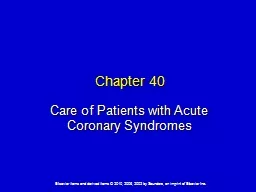

Coronary Artery Disease Includes stable angina and acute coronary syndromes Ischemia insufficient oxygen supply to meet the requirements of the myocardium Infarction necrosis or cell death that occurs when severe ischemia is prolonged and decreased perfusion causes irreversible dam ID: 909776
Download Presentation The PPT/PDF document "Chapter 40 Care of Patients with Acute C..." is the property of its rightful owner. Permission is granted to download and print the materials on this web site for personal, non-commercial use only, and to display it on your personal computer provided you do not modify the materials and that you retain all copyright notices contained in the materials. By downloading content from our website, you accept the terms of this agreement.
Slide1
Chapter 40
Care of Patients with Acute Coronary Syndromes
Slide2Coronary Artery Disease
Includes stable angina and acute coronary syndromes
Ischemia
—
insufficient oxygen supply to meet the requirements of the myocardium
Infarction
—
necrosis or cell death that occurs when severe ischemia is prolonged and decreased perfusion causes irreversible damage to tissue
Slide3Coronary Blood Flow
Slide4Chronic Stable Angina Pectoris
“Strangling of the chest”
Temporary imbalance between the coronary artery’s ability to supply oxygen and the cardiac muscle’s demand for oxygen
Ischemia limited in duration and does not cause permanent damage to myocardial tissue
Chronic stable angina
Unstable angina
Slide5Acute Coronary Syndromes
Patients who present with either unstable angina or an acute myocardial infarction
Slide6ST Segment Elevation and MI
ST elevation MI (STEMI) traditional manifestation
Non
–
ST elevation MI (non-STEMI) common in women
Unstable angina
Slide7Unstable Angina Pectoris
New-onset angina
Variant (Prinzmetal’s) angina
Pre-infarction angina
Slide8Myocardial Infarction
Most serious acute coronary syndrome
Occurs when myocardial tissue is abruptly and severely deprived of oxygen
Occlusion of blood flow
Necrosis
Hypoxia
Subendocardial MI, transmural MI, inferior wall MI
Ventricular remodeling
Slide9Nonmodifiable Risk Factors
Age
Gender
Family history
Ethnic background
Slide10Modifiable Risk Factors
Elevated serum cholesterol
Cigarette smoking
Hypertension
Impaired glucose tolerance
Obesity
Physical inactivity
Stress
Slide11Laboratory Assessment
Troponin T and troponin I
Creatine kinase-MB (CK-MB)
Myoglobin
Imaging assessment
12-lead electrocardiograms
Cardiac catheterization
Slide12Acute Pain
Interventions include:
Provide pain-relief modalities,
drug therapy.
Decrease myocardial oxygen demand.
Increase myocardial oxygen supply.
Slide13Pain Management
Nitroglycerine
Morphine sulfate
Oxygen
Position of comfort; semi-Fowler’s position
Quiet and calm environment
Deep breaths to increase oxygenation
Slide14Ineffective Tissue Perfusion (Cardiopulmonary)
Interventions include:
Drug therapy (aspirin, thrombolytic agents)
Restoration of perfusion to the injured area often limits the amount of extension and improves left ventricular function.
Complete sustained reperfusion of coronary arteries in the first few hours after an MI has decreased mortality.
Slide15Heparin for Acute Coronary Syndrome
Slide16Thrombolytic Therapy
Fibrinolytics dissolve thrombi in the coronary arteries and restore myocardial blood flow.
Tissue plasminogen activator
Reteplase
Tenecteplase
Slide17Thrombolytic Drugs; Clot Dissolving Drugs
Slide18Other Drugs
Glycoprotein (GP) IIB/IIIa inhibitors
Once-a-day beta-adrenergic blocking agents
Angiotensin-converting enzyme inhibitors or angiotensin receptor blockers
Calcium channel blockers
Ranolazine
Slide19Percutaneous Transluminal Coronary Angioplasty (PTCA)
Slide20Activity Intolerance Interventions
Cardiac Rehabilitation:
Phase 1
Phase 2
Phase 3
Slide21Ineffective Coping Interventions
Assess the patient’s level of anxiety, but allow expression of any anxiety and attempt to define its origin.
Give simple explanations of therapies, expectations, and surroundings and explanations of progress to help relieve anxiety.
Provide coping enhancement.
Slide22Potential for Dysrhythmias
Dysrhythmias are the leading cause of death in most patients with MI who die before they can be hospitalized.
Interventions include:
Identify the dysrhythmias.
Assess hemodynamic status.
Evaluate for discomfort.
Slide23Cardiogenic Shock
Necrosis of more than 40% of the left ventricle
Tachycardia
Hypotension
Blood pressure <90 mm Hg or 30 mm Hg less than patient’s baseline
Urine output <30 mL/hr
Slide24Cardiogenic Shock (Cont’d)
Cold, clammy skin
Poor peripheral pulses
Agitation, restlessness, confusion
Pulmonary congestion
Tachypnea
Continuing chest discomfort
Slide25Medical Management
Pain relief and decreased myocardial oxygen requirements through preload and afterload reduction
Drug therapy
Intra-aortic balloon pump
Immediate reperfusion
Slide26Percutaneous Transluminal Coronary Angioplasty
Clopidogrel before the procedure
IV heparin after the procedure
IV or intracoronary nitroglycerine or diltiazem
Possible IV GP IIb/IIIa inhibitors
Long-term therapy, antiplatelet therapy, beta blocker, ACE inhibitor or ARB
Slide27Other Procedures
Arthrectomy
Stents
Rheolytic thrombectomy
Slide28Coronary Stent
Slide29Coronary Artery Bypass Graft Surgery
Slide30CABG
Slide31CABG (Cont’d)
Preoperative care
Operative procedures
Postoperative care:
Management of F&E balance
Management of other complications
—
hypotension, hypothermia, hypertension, bleeding, cardiac tamponade, change in level of consciousness
Slide32Community-Based Care
Home care management
Health teaching
Health care resources